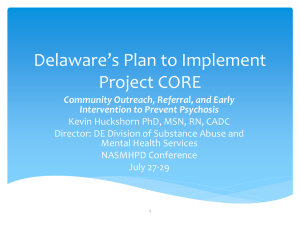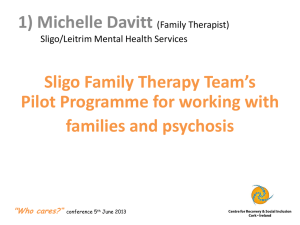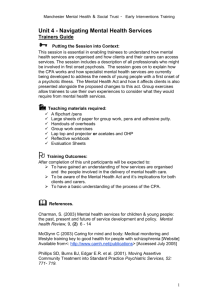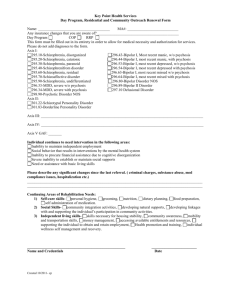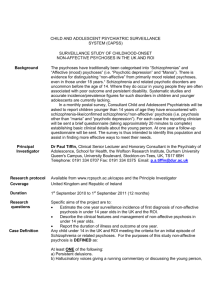Preventing Psychotic Disorders by Early Detection and Intervention
advertisement
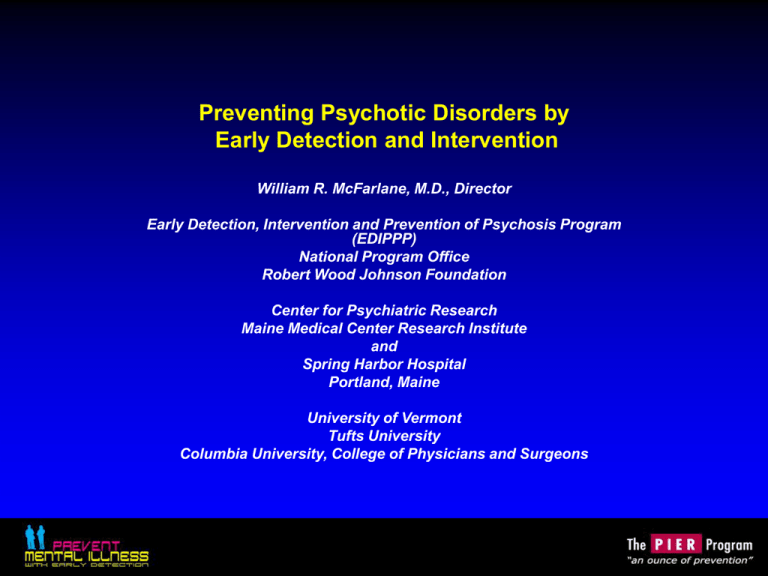
Preventing Psychotic Disorders by Early Detection and Intervention William R. McFarlane, M.D., Director Early Detection, Intervention and Prevention of Psychosis Program (EDIPPP) National Program Office Robert Wood Johnson Foundation Center for Psychiatric Research Maine Medical Center Research Institute and Spring Harbor Hospital Portland, Maine University of Vermont Tufts University Columbia University, College of Physicians and Surgeons Collaborators • William L. Cook, PhD • Donna Downing, MS, OTR/L • Anita Ruff, MPH • Brenda Joly, PhD • Kimberly Pukstas • Diane Parham, O.T.R./L • • • • • Karen Milner, MD Cameron Carter, MD Barbara Cornblatt, PhD Steven Adelsheim, MD Bentson McFarland, MD, PhD Early detection and prevention in another illness “If you catch cancer at Stage 1 or 2, almost everybody lives. If you catch it at Stage 3 or 4, almost everybody dies. We know from cervical cancer that by screening you can reduce cancer up to 70 percent. We’re just not spending enough of our resources working to find markers for early detection.” ---Lee Hartwell, MD Nobel Laureate, Medicine President and Director, Hutchinson Center New York Times Magazine December 4, 2005, p. 56 Shortened productive lives Cardiovascular disease Mental illness Cancer Respiratory disease Alcohol use Infectious disease Drug abuse 0 5 10 Productive years lost Source: Mental Health Report of the Surgeon General 15 20 $10 million Lifetime costs for each new case of schizophrenia 25 Years of life lost by people with schizophrenia due to all causes, including heart disease, cancer and suicide Functioning as an effect of number of psychotic episodes 100 90 Functioning (GAF) 80 70 60 50 40 30 20 10 0 0 1 2 3 Number of episodes 4 5 6 Empirical evidence for a relationship between a long DUP and a poor prognosis • Johnstone et al. 1986: Many psychotic patients did not get appropriate treatment early, even when they sought help. • Crow et al. 1986: DUP more important for the course than maintenance medication. • Rabiner et al 1986: Long DUP was related to a poor one year outcome. • Wyatt 1991,Opjordsmoen 1991: Earlier treatment predicted better course. Effects of untreated initial psychosis • Being psychotic is a personal disaster and the longer it lasts, the more it can become traumatic and stigmatizing. • Being psychotic reduces cognitive and social function. They may lose contact with family and friends, fail school, or drop out of work. • The longer the psychosis lasts, the more difficult it may be for the therapist to establish a good therapeutic relationship with the patient. • Neurobiological deficit processes linked to symptom formation may possibly proceed unlimited as long as the patient is untreated. High Validity of diagnosis across phases of illness Premorbid period Prodromal period Defined Diagnosis Neurological disease (Cerebral AIDS, SLE, MS. etc.) Chronic undifferentiated schizophrenia Paranoid schizophrenia Schizo-obsessive disorder. 0 Schizo-affective disorder “NRG-1 disorder” Psychotic bipolar disorder Psychotic depressive disorder High Validity of clinical differential diagnosis Dementia praecox, deficit schizophrenia Severe agoraphobia time Early Insults e.g. Disease Genes, Possibly Viral Infections, Environmental Toxins Social and Environmental Triggers Biological Vulnerability: CASIS Brain Abnormalities Cognitive Deficits Affective Sx: Depression Social Isolation Disability School Failure Structural Biochemical Functional After Cornblatt, et al., 2005 NP Profile of Clinical High Risk (CHR) sample relative to Healthy Comparisons (HC) Non-genetic biologic and psychosocial risk factors • Prenatal infections (influenza, rubella, toxoplasma, herpes s.) • Winter birth • Prenatal toxic exposure (lead) • Obstetrical complications • Head trauma (perinatal to adolescence) • Autoimmune (Rh incompatibility, thyroid, type 1 diabetes, celiac disease) • Nutrition (starvation, omega-3 deficiency) • Heavy metal exposure, maternal/fetal • Heavy cannabis, other drug exposure • Urban residence • Exposure to trauma, with PTSD • Negative emotional experience Cortical volume reduction, in childhood-onset schizophrenia, ages 14-19 Expressed emotion • • • • Critical comments Hostility Over-involvement Warmth Proportion of families with high EE in years following onset 50% 50% 35% 40% 30% 20% 14% 10% 0% > 1 year 1-3 years >5 years Hooley, et al, 1995 Effects of genetic risk and family functioning on eventual schizophreniaspectrum disorders % of sub-sample 40 36.8 35 30 Low OPAS ratings 25 High OPAS ratings 20 15 10 5.8 5 4.8 5.3 0 High-risk, spectrum (n=145)* * p < 0.001 **p = 0.582 G X E interaction: p=0.018 Low-risk, spectrum (n=158)** Tienari, Wynne, et al, BJM, 2004 Mutual causal effects: Patient symptoms and family interaction Biosocial causal interactions in late schizophrenic prodrome Perceptual distortions Pervasive anxiety Acute onset Withdrawal "Oddness" Functional deterioration Social & performance Social deficits deficits Family/Social Physiological Late prodrome Critical comments CD, EOI Anxiety Panic Misattribution High EE Illusions Dread Insomnia Anorexia Psychosis Structural Early prodrome Social networks in schizophrenia • Family network size – diminishes with length of illness – decreases in the period immediately following a first episode – is smaller at the time of first admission • Networks – buffer stress and adverse events – determine treatment compliance – predict relapse rate – correlate with coping skills and burden. Is early intervention indicated prevention of psychotic disorders? Probably “Yes, we can?” Trials of Indicated Prevention • Buckingham, UK • EDIE, UK • German Research Network • OPUS, Denmark • TIPS, Norway, Denmark • PACE, Australia • PRIME, North America • Omega-3 FAs, Austria • PIER, Maine • EDIPPP, USA % converting to psychosis Psychosis prevention studies: One year rates for conversion to psychosis 40 32 35 30 25 20 15 9.9 10 5 0 Controls Experimental PACE PRIME OPUS PIER EDIE Amminger Mean rate Portland Identification and Early Referral (PIER) Reducing the incidence of major psychotic disorders in a defined population, by early detection and treatment: Indicated prevention Project Overview PIER Education Clinical Work Research Material Development Assessment Professionals Psychosocial Treatment General Public Pharmacological Treatment Greater Portland Area BIOLOGICAL RISK FACTORS Population 33O,OOO Experimental Catchment Area: Vital statistics Population, 2007 ~340,000 Expected incidence, schizophrenia 34 (10/100,000) Expected incidence, psychosis 116 (34/100,000) Towns 28 Public high schools 25 Public middle schools 23 Private schools, all types 38 Colleges and universities 4 Psychiatric inpatient beds 134 Professional and Public Education • Reducing stigma • Information about modern concepts of psychotic disorders • Increasing understanding of early stages of mental illness and prodromal symptoms • How to get consultation, specialized assessments and treatment quickly • Ongoing inter-professional collaboration Youth Education • Public service announcements by mainstream television and health information programs • Interviews and spot announcements by youth television cable network • 2-3 sessions on early warning signs as part of the obligatory 10th grade health curriculum • Widespread distribution of bookmarks and posters throughout catchment area schools, colleges, bookstores • Art and literature contest • Major publicity events during Mental Illness Awareness Week • Youth oriented website: www.preventmentalillness.org MentalPIER Welcome Getting About Contact News Resources illness help Home | Contact Us | Disclaimer |Copyright©2005. Site by ACES Design - illustrations by Alan Claude Family practitioners College health services Pediatricians Mental health clinicians Military bases and recruiters School teachers, guidance counselors, nurses, social workers PIER Team Clergy Employers Advertising Emergency and crisis services General Public Family practitioners College health services Pediatricians School guidance counselors, nurses, social workers Mental health clinicians Military bases and recruiters PIER Team Employers Clergy Emergency and crisis services General Public Clinical Strategies Signs of prodromal psychosis Schedule of Prodromal Syndrome (SOPS), McGlashan, et al A clustering of the following: Changes in behavior, thoughts and emotions, with preservation of insight, such as: Heightened perceptual sensitivity To light, noise, touch, interpersonal distance Magical thinking Derealization, depersonalization, grandiose ideas, child-like logic Unusual perceptual experiences “Presence”, imaginary friends, fleeting apparitions, odd sounds Unusual fears Avoidance of bodily harm, fear of assault (cf. social phobia) Disorganized or digressive speech Receptive and expressive aphasia Uncharacteristic, peculiar behavior Satanic preoccupations, unpredictability, bizarre appearance Reduced emotional or social responsiveness “Depression”, alogia, anergia, mild dementia Signs of prodromal psychosis Changes in behavior, thoughts and emotions, with preservation of insight, such as: Unusual perceptual experiences “Presence”, shadows, visual trails, ghosts Imaginary friends Fleeting apparitions Odd sounds Somatic illusions or hallucinations Heightened or dulled perceptions Vivid sensory experiences Sensations and thoughts located outside the body Frequent distortions or illusions Brief but frank hallucinations, minimal effect on behavior or thinking Signs of prodromal psychosis Changes in behavior, thoughts and emotions, with preservation of insight, such as: Unusual fears Marked guardedness, distrustful Fear of assault (not social phobia) Avoidance of bodily harm Somatic delusions Severe nihilism Persistent persecutory self-referential thoughts Paranoia Extreme guilt, fear of harming others Bizarre obsessional preoccupations Fears of mind-reading Frank delusions, without full conviction Signs of prodromal psychosis Changes in behavior, thoughts and emotions, with preservation of insight, such as: Disorganized or digressive speech and thoughts Receptive aphasia: “Can’t understand others.” Expressive aphasia: “Can’t be understood.” Odd, circumstantial, tangential, paralogical speech Overly simple speech Loss of gist of conversation, poor abstracting Rigid, concrete, almost autistic thinking Loosening of associations Marked vagueness, lack of clarity of subjects and objects Racing speech Stereotyped ideas, speech Over-elaborate speech Poor problem-solving Signs of prodromal psychosis • 2. Significant deterioration in functioning – – – – Unexplained decrease in work or school performance Decreased concentration and motivation Decrease in personal hygiene Decrease in the ability to cope with life events and stressors • 3. Social withdrawal – Loss of interest in friends, extracurricular sports/hobbies – Increasing sense of disconnection, alienation – Family alienation, resentment, increasing hostility, paranoia Family-aided Assertive Community Treatment (FACT): Clinical and functional intervention • Rapid, crisis-oriented initiation of treatment • Psychoeducational multifamily groups • Case management using key Assertive Community Treatment methods – Integrated, multidisciplinary team; outreach PRN; rapid response; continuous case review • Supported employment and education – Collaboration with schools, colleges and employers Family-aided Assertive Community Treatment (FACT): Clinical and functional intervention • Cognitive assessments used in school or job • Low-dose atypical antipsychotic medication – aripiprazole 10-20 mg, quetiapine 300-600 mg, olanzapine 2.5-7.5 mg, risperidone 0.25-3 mg • Mood stabilizers, as indicated by symptoms: – Mood stabilizing drugs: lamotrigine 50-150 mg, valproate 5001500mg, lithium by blood level • SSRIs, with caution, especially with aripiprazole and/or a family history of manic episodes Key clinical strategies in family intervention specific to prodromal psychosis • Strengthening relationships and creating an optimal, protective home environment: – – – – Reducing intensity, anxiety and over-involvement Preventing onset of negativity and criticism Adjusting expectations and performance demands Minimizing internal family stressors • Marital stress • Sibling hostility • Conceptual and attributional confusion and disagreement Key clinical strategies in family intervention specific to prodromal psychosis • Strengthening relationships and creating an optimal, protective home environment: – Buffering external stressors • Academic and employment stress • Social rejection at school or work • Cultural taboos • Entertainment stress • Romantic and sexual complications Key clinical strategies in family intervention specific to prodromal psychosis • Individualized, responsive education for single families • Little discussion of atrophic aspects of brain functioning emphasis on transient, stress-induced hyperactivity in some brain areas and some biochemical systems • Accelerated recovery, reentry and rehabilitation • Emphasis on careful forward progress. – "Slow down personal and career advancement, until stability and motivation returns." PIER: Outcomes after one year of treatment Data for 148 at-risk cases from the first 6 years intake: May 7, 2001- September 6, 2007 Community Education and Training: Results Outreach events 325 Public schools and colleges trained 100% Professionals trained 7270 Bookmarks distributed >70,000 Resource guides distributed >1400 Website hits (2005-2007) 1,071/day Website sessions (2005-2007) 56.3/day Total hits (2005-2007) >500,000 Surveys: Awareness of PIER in area, 2001 vs. 2007 8% vs. 19% Figure 1. Disposition of all contacts with PIER, 5/7/2001-9/1/2007 All contacts N=1333 Request for information Case Referrals N=180 N=1103 Request for presentation N=50 In catchment area N=921 Age 12-35 N=780 Referred Elsewhere N=240 (30.8%) No further contact required N=51 (6.5%) Screened for formal assessment N=404 (51.8%) Contact withdrawn N=85 (10.9%) Referred Elsewhere N= 74 (18.3%) Presumed Psychotic N=47 (11.6%) Completed SIPS N=271 (67.1%) Contact withdrawn or did not complete SIPS N=9 (2.2%) Psychotic by POPS criteria Met SOPS criteria N=32 (11.8%) N=148 (54.6%) Did not meet SOPS criteria N=94(34.7%) Declined treatment Treated > 3 months N=10 (6.8%) N=118 (79.7%) Dropped out in < 3 months N=22 (14.9%) Efficiency of identification: Diagnosis for those screened as at risk n = 780 Referred for another disorder 314 40.2% Prodromal 148 19.0% Psychosis 79 10.1% Any psychiatric illness 589 69.4% Referral sources: Distribution Non-mental health sources 52.3% Tertiary sources 21.5% Mental health sources 26.2% Screening and treatment entry Referrals 780 100.0% SIPS Completed 271 34.8% Met SOPS Criteria 148 54.6% Declined treatment 10 6.8% Dropped out <3 Months 22 14.9% 116 78.4% Treated sample Demographics of the treated sample Males (age range 12 - 27) Females (age range 12 - 24) 53.4% 46.6% Average age 16.5 DSM-IV Substance abuse disorder 15% Treated cases converting to psychosis within 12 months (n = 93) • Cases not converted 72 77.4% • Cases converted, 1-6 days 5 5.4% • Cases converted, 7-30 days 7 7.5% • SOPS psychosis conversions 5 5.4% • Schizophrenic disorder 4 4.3% • Total SOPS conversions 9 9.7% SOPS scores at baseline and 12 months 3 S u b s c a l e Baseline 12 months 2.5 s 2 c o 1.5 r 1 e p<.001 p<.001 p<.001 p<.001 0.5 0 Positive n=94 Negative Disorganized SOPS Subscale General Overall functioning: Baseline and 12 months 70 56.5 60 50 38.1 40 30 20 10 0 Baseline N=94; p<.01 12 month Components of expressed emotion: Prodromal vs. chronic phase 7 Scale score 6 5 4 3 2 1 Chronic schizophrenia 1 Warmth Chronic schizophrenia 2 Rejection Prodromal Mothers Protectiveness All differences, prodromal vs. chronic: p<0.01 Fusion Prodromal Fathers Difference in Initial Admissions Portland vs. 3 Maine Urban Areas, Ages 12-25 10 Admissions/100,000 0 6.3 -10 -20 -30 Incidence difference, mean: Portland vs 3 urban areas: 65/100,000 % of Portland baseline: 60% -58.5 -40 -50 -60 1994-2000 2001-2007 Admissions/100,000 Difference in Initial Admissions Rates for Psychosis Portland minus 3 Maine urban areas, Ages 12-25 80 60 40 20 0 -20 -40 -60 -80 -100 -120 1994 1995 1996 1997 1998 1999 2000 2001 PIER begins 2002 2003 2004 2005 2006 2007 Differences In Initial Admission Rates/100,000 For All Psychoses, Ages 12-35, 1994-2000 Vs. 2001-2007: Portland Vs. Control Catchment Areas In Maine Central 46.1 Eastern 40 19.4 20 -0.2 Western 27.5 Mean, 3 areas 6.6 Rest of Maine 0 -20 -22.9 -40 -41.9 -60 -35.5 -42.1 -51.8 1994-2000 2001-2007 Difference in incidence/100,000 60 Incidence in Portland and 3 urban areas All Psychosis, ages 12-25 80 y = 1.4x + 35.9 Admissions/100,000 70 60 y = 0.7x + 30.4 50 40 30 20r = -0.53 2001 2002 2003 2004 Portland Urban Control 2005 2006 2007 Admissions/100,000 First admissions to Maine hospitals for a psychotic or major mood disorder, 1990-2007 Ages 12-25 50 45 40 35 30 25 20 15 10 5 0 1991 1993 1995 1997 1999 2001 2003 2005 2007 Source: MHDO data, analyzed by Maine Health Information Center and Maine Medical Center Research Institute Hospitalization costs avoided* Portland vs. 3 other Maine cities 2002 Average: 2001-2007 2007 Cases not admitted Days in hospital Hospital daily rate Annual costs avoided 36.8 10 $900 $331,200 36.8 13 $1,600 $765,440 62.7 10 $900 $564,300 62.7 13 $1,600 $1,304,160 89.5 10 $900 $805,500 89.5 13 $1,600 $1,861,600 *Savings from avoided initial hospitalizations in Portland. Cost estimates based on incidence rate differences (i.e., resulting fewer cases) between greater Portland and the other 3 Maine urban areas. Amounts are based on time period—2002, 2007 or the average for 2001-2007—days in hospital for first admission and daily rate in dollars. Population based on US Census estimates for the respective years. Differences between treated prodromal and post-psychotic states Prodromal young persons have manifested: • Maintenance of insight (prevention of loss) • Continued ego-dystonic response to psychotic symptoms • High acceptance of, and adherence to, treatment • Low rates of substance abuse • More open to discontinuing heavy drug and alcohol abuse • Less resistance to family inclusion by patient • Higher motivation to continue schooling and/or work • More trusting and grateful therapeutic relationships • Higher sensitivity to treatments • Higher likelihood of improving course of functioning Conclusions • Public education is influencing attitudes, knowledge and behavior. • Accurate referrals are coming from outside the mental health system. • Treatment is blocking the final common pathway to psychosis. • Medication at low doses is adequate but appears essential for prevention of imminent, and perhaps later, psychosis. • Very low conversion rates and functional improvement accompany comprehensive treatment (~15%; ~5% for schizophrenic disorders). • A substantial proportion of the incident population can be identified and prevented from developing psychosis. PIER Sponsors PIER has been made possible with the generous support of: Robert Wood Johnson Foundation National Institute of Mental Health Center for Mental Health Services (SAMHSA) State of Maine Maine Health Access Foundation Bingham Fund Betterment Fund Brain Foundation American Psychiatric Foundation UnumProvident Foundation Wrendy Haines Fund


